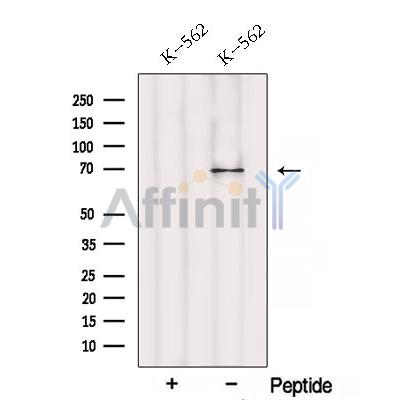Ribophorin I Antibody - #DF12727
| 製品: | Ribophorin I Antibody |
| カタログ: | DF12727 |
| タンパク質の説明: | Rabbit polyclonal antibody to Ribophorin I |
| アプリケーション: | WB IF/ICC |
| 反応性: | Human, Mouse, Rat, Monkey |
| 予測: | Pig, Bovine, Horse, Rabbit, Dog, Xenopus |
| 分子量: | 69 kDa; 69kD(Calculated). |
| ユニプロット: | P04843 |
| RRID: | AB_2845688 |
製品説明
*The optimal dilutions should be determined by the end user. For optimal experimental results, antibody reuse is not recommended.
*Tips:
WB: For western blot detection of denatured protein samples. IHC: For immunohistochemical detection of paraffin sections (IHC-p) or frozen sections (IHC-f) of tissue samples. IF/ICC: For immunofluorescence detection of cell samples. ELISA(peptide): For ELISA detection of antigenic peptide.
引用形式: Affinity Biosciences Cat# DF12727, RRID:AB_2845688.
折りたたみ/展開
D6Wsu137e; Dolichyl diphosphooligosaccharide protein glycosyltransferase 67 kDa subunit; Dolichyl diphosphooligosaccharide protein glycosyltransferase 67 kDa subunit precursor; Dolichyl-diphosphooligosaccharide--protein glycosyltransferase 67 kDa subunit; Dolichyl-diphosphooligosaccharide--protein glycosyltransferase subunit 1; EC 2.4.1.119; Oligosaccharyltransferase 1 homolog; oligosaccharyltransferase complex subunit (non-catalytic); OST1; RBPH1; Ribophorin I; Ribophorin-1; RPN-I; Rpn1; RPN1_HUMAN;
免疫原
A synthesized peptide derived from human Ribophorin I, corresponding to a region within C-terminal amino acids.
- P04843 RPN1_HUMAN:
- Protein BLAST With
- NCBI/
- ExPASy/
- Uniprot
MEAPAAGLFLLLLLGTWAPAPGSASSEAPPLINEDVKRTVDLSSHLAKVTAEVVLAHLGGGSTSRATSFLLALEPELEARLAHLGVQVKGEDEEENNLEVRETKIKGKSGRFFTVKLPVALDPGAKISVIVETVYTHVLHPYPTQITQSEKQFVVFEGNHYFYSPYPTKTQTMRVKLASRNVESYTKLGNPTRSEDLLDYGPFRDVPAYSQDTFKVHYENNSPFLTITSMTRVIEVSHWGNIAVEENVDLKHTGAVLKGPFSRYDYQRQPDSGISSIRSFKTILPAAAQDVYYRDEIGNVSTSHLLILDDSVEMEIRPRFPLFGGWKTHYIVGYNLPSYEYLYNLGDQYALKMRFVDHVFDEQVIDSLTVKIILPEGAKNIEIDSPYEISRAPDELHYTYLDTFGRPVIVAYKKNLVEQHIQDIVVHYTFNKVLMLQEPLLVVAAFYILFFTVIIYVRLDFSITKDPAAEARMKVACITEQVLTLVNKRIGLYRHFDETVNRYKQSRDISTLNSGKKSLETEHKALTSEIALLQSRLKTEGSDLCDRVSEMQKLDAQVKELVLKSAVEAERLVAGKLKKDTYIENEKLISGKRQELVTKIDHILDAL
種類予測
Score>80(red) has high confidence and is suggested to be used for WB detection. *The prediction model is mainly based on the alignment of immunogen sequences, the results are for reference only, not as the basis of quality assurance.
High(score>80) Medium(80>score>50) Low(score<50) No confidence
研究背景
Subunit of the oligosaccharyl transferase (OST) complex that catalyzes the initial transfer of a defined glycan (Glc(3)Man(9)GlcNAc(2) in eukaryotes) from the lipid carrier dolichol-pyrophosphate to an asparagine residue within an Asn-X-Ser/Thr consensus motif in nascent polypeptide chains, the first step in protein N-glycosylation. N-glycosylation occurs cotranslationally and the complex associates with the Sec61 complex at the channel-forming translocon complex that mediates protein translocation across the endoplasmic reticulum (ER). All subunits are required for a maximal enzyme activity.
Endoplasmic reticulum. Endoplasmic reticulum membrane>Single-pass type I membrane protein. Melanosome.
Note: Identified by mass spectrometry in melanosome fractions from stage I to stage IV.
Expressed in all tissues tested.
Belongs to the OST1 family.
研究領域
· Genetic Information Processing > Folding, sorting and degradation > Protein processing in endoplasmic reticulum. (View pathway)
· Metabolism > Glycan biosynthesis and metabolism > N-Glycan biosynthesis.
· Metabolism > Global and overview maps > Metabolic pathways.
Restrictive clause
Affinity Biosciences tests all products strictly. Citations are provided as a resource for additional applications that have not been validated by Affinity Biosciences. Please choose the appropriate format for each application and consult Materials and Methods sections for additional details about the use of any product in these publications.
For Research Use Only.
Not for use in diagnostic or therapeutic procedures. Not for resale. Not for distribution without written consent. Affinity Biosciences will not be held responsible for patent infringement or other violations that may occur with the use of our products. Affinity Biosciences, Affinity Biosciences Logo and all other trademarks are the property of Affinity Biosciences LTD.


